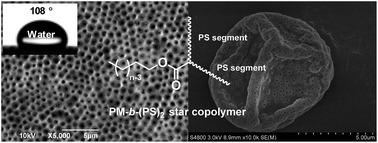New polymethylene-based AB2 star copolymers synthesized via a combination of polyhomologation of ylides and atom transfer radical polymerization
Abstract
New polymethylene-based AB2 star polymers with well-defined architecture and various components were synthesized using a combination of polyhomologation of ylides and atomic transfer radical polymerization (ATRP). The chain structures of polymethylene-b-(polystyrene)2 (PM-b-(PS)2) and polymethylene-b-(poly(methyl methacrylate))2 (PM-b-(PMMA)2) were characterized through 1H NMR, GPC and FT-IR. The porous films of such star copolymers were fabricated via a static breath-figure (BF) process. The influence of polymer molecular weight, solution concentration and environmental temperature on the morphology of such block copolymer films was investigated. The porous surface of such a film presents hydrophobic behaviour with a static water-droplet contact angle of ca. 108°. The electrospinning of PM-b-(PS)2 was performed using CHCl3 as a solvent and the wrinkle-like polymer particles with nanopores on their surface were obtained.


 Please wait while we load your content...
Please wait while we load your content...